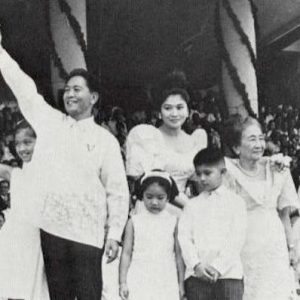There are people wondering why there is such a strong push to have the remains of former President Ferdinand Marcos interred at the Libingan ng mga Bayani (LNMB). Perhaps these people need to approach that question from the perspective of the “other side”. If you were one of the Marcoses, wouldn’t you want former President Ferdinand Marcos buried at the LNMB?
Of course you would. The law allows it. Marcos is a former Philippine president and a soldier. And the current sitting president, Rodrigo Duterte, is all for it. So then people further ask, why is Duterte acceding to the Marcoses’ wishes? Again, perhaps stepping into Duterte’s shoes and thinking the way he might be thinking would help in this little mental exercise. If you were Duterte, how would you refuse the Marcoses’ wishes?

As a duly elected president of the republic, Ferdinand Marcos is qualified for burial at the Libingan ng mga Bayani.
The only reason people who regard themselves as “anti-Marcos” are outraged by the idea of burying Marcos’s remains at the LNMB is because they have, for decades, been indoctrinated not just to hate Marcos but to extend that hate to the rest of his family.
The fact is, pulling off the burial of Marcos at the LNMB will be a monumental triumph for the Marcos family. It will see Philippine history coming full circle. Marcos buried at the LNMB will prove a point — that his ouster in 1986 was anextrajudicial change in leadership. In other words, the ascent to power of his successor, the late former President Cory Aquino was against the law.
How fitting that President Duterte who, under his watch, the word “extrajudicial” became a fashion statement bandied around by a noisy clique of self-described “human rights” advocates is overseeing the closure of a three-decade era built upon an unlawful transition of power. Indeed, the 1986 EDSA people power “revolution” set a precedent for succeeding governments to disregard the law. This addiction to “people power” as a means to get things done became a virulent social cancer and a blanket threat that was kept hanging over the heads of the succession of presidents that followed. Even today, rumblings of a threat to mount, yet again, some sort of “people power” spectacle to unseat Duterte are beginning to ripple across the chattering classes.
Now that the Yellow camp of the Aquinos is back to being the dominant “Opposition”, we may be seeing the dawn of a resurgence of “people power” activism. Will a “people power” Opposition once again capture the hearts of the Filipino people?
Perhaps, surrounding this possibility is where the Marcos burial at the LNMB is at its most relevant. Once Marcos is interred at the LNMB, it is pretty muchGame Over for the Yellow camp. In any case, Filipinos are on to them. In the shrill activism they had been mounting against the LNMB burial, the Yellow camp have revealed an unhealthy fixation on a historical account that is, if intelligently scrutinised, not an entirely factual account. In his Manila Timesarticle On the Marcos issue, media and the academe have failed us, columnist Bobi Tiglao calls out the failure of the foremost institutional bastion of rabid anti-Marcos rhetoric, the Ateneo de Manila University, for its ironic failure to produce “a single piece of scholarship that would contribute to our balanced assessment of the Martial Law era”.
The research of its 34-member [history department] faculty consists of such things as “manga comics during the Japanese occupation,” “Jesuit linguistic battles from 1898-1932, “Spirit beliefs among 18th century Aeta and Ilongots,” “American schoolbooks in Philippine classrooms,” “Kempetai in the Philippines,” and “Engkuwentro: Kayaw contra digmaang-galrea, 1565-1571” (whatever that is).Do these historians think that it is below them to do research on the Plaza Miranda bombing, the fiction of the Jabidah massacre, the coconut industry’s role in the Muslim rebellion, the Communist Party of the Philippines’ support from China, or the role of the global debt crisis on Marcos’ fall?What Aguinaldo ate for breakfast, how much Mabini loved carabao milk, what Rizal’s physical dimensions were — the kind of historical research the Ateneo seems to prefer — certainly make for fascinating read over morning coffee. These are, however, irrelevant to our understanding of our nation
And so, Tiglao concludes…
Our academic community’s failure explains why many can’t see how preposterous it is to refuse the burial in the armed forces’ national cemetery of the remains of somebody who served as President, an Army major, and a Bataan Death March victim — facts of history even anti-Marcos scholars do not question.
The reality that the Yellow camp need to face is quite confronting. They have none other but themselves to blame for the triumph of the Marcoses. Their shrill “activism” today, loud and shrieky as it may be, comes across as a sad case of too much noise too late after three decades of wasted opportunity.
http://www.getrealphilippines.com/blog/2016/08/marcoss-burial-lnmb-proves-point-ouster-1986-law/

No comments:
Post a Comment